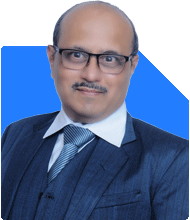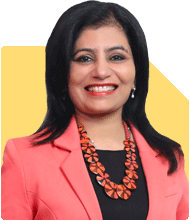Ramalingam Kalirajan |9758 Answers |Ask -Follow
Mutual Funds, Financial Planning Expert - Answered on May 21, 2024
He has an MBA in finance from the University of Madras and is a certified financial planner.
He is the director and chief financial planner at Holistic Investment, a Chennai-based firm that offers financial planning and wealth management advice.... more

Hi myself 36 yrs old Started mf plan very late Luckily due to organisation switch got company stocks vested to me around 85 lacs and still around 60 lacs not yet vested . With that confidence I have taken home loan of 1.2cr for 25 yrs Emi amt 1 lac per month rate of interest 8.5 Not much invested earlier in mf started late around 1.5 yrs back Was able to accumulate 5 lacs total Invested in stocks around 2 lacs Now am trying to do sip every month of 42k I earn around 2.2lacs I have 2 more loans apart from home loan Personal loan of 26k emi 4 yrs pending Gold loan yearly emi payment of 6 lacs amount. Deduction of 1 lac + 26k+ 42k = 1.68 lacs goes to emis Yearly gold I have to pay around 60k without principal I consider 1.75 lacs to fixed amt goes as cuttings. I have remaining around 40k I think Home necessities cost around 15k monthly I still have around 20 to 25k remaining As I have started very late in mf I want to increase my sip for my kids education and future retirement plans I have something in mind which am bit afraid I want to sell stocks and invest in real estate and do the rotation of money for 10 years. But i have limited knowledge after doing some research . Should I go ahead with that ? Or Should I close my home loan using my stocks and reduce to 40 lacs home loan something Invest same amount in sips ? My stocks are in US market ..should I sell or not ? Company stocks are till now going well.. How high it would jump and how much it will take for that to happen I don't know Please suggest me to some investment ideas Q1. Should I close home loan Q2. Should I invest in real estate Q3. Should I invest stocks amt in mutual funds Any better ideas and suggestions please advise ..
Your current financial situation reflects both opportunities and challenges. You have accumulated a significant amount of company stocks and started investing in mutual funds. Your home loan and other liabilities add to your monthly financial commitments. It's essential to strategically manage your investments to ensure long-term financial stability.
Assessing the Home Loan
Paying off your home loan can provide a sense of financial relief. However, consider the opportunity cost of using your stocks for this purpose. With an interest rate of 8.5%, the cost of maintaining the home loan is relatively high. Reducing your home loan can decrease your monthly EMI, providing more cash flow for investments and other expenses. However, before deciding, consider the potential growth of your stocks. If the stocks have significant growth potential, retaining them might be more beneficial in the long run.
Evaluating Real Estate as an Investment
Investing in real estate can be tempting, but it comes with several challenges. Real estate investments require substantial capital and involve high transaction costs. They also lack liquidity compared to stocks and mutual funds. The real estate market can be unpredictable, and managing properties requires time and effort. Given these factors, real estate might not be the best option for someone seeking to simplify and strengthen their financial portfolio.
Investing in Mutual Funds
Mutual funds offer a diversified investment option that can align with your financial goals. Given your late start in mutual funds, it’s wise to increase your SIPs to build a substantial corpus over time. Actively managed funds can offer better returns due to professional management. These funds allow you to benefit from the expertise of fund managers, providing a balanced risk-return ratio.
Disadvantages of Index Funds and Direct Funds
Index funds, while low-cost, do not always outperform actively managed funds. They mirror market performance, lacking the flexibility to adapt to market changes. On the other hand, direct mutual funds require active monitoring and decision-making. Investing through a Certified Financial Planner (CFP) can provide valuable insights and professional management, helping you navigate complex market conditions effectively.
Strategic Use of Stocks
Your company stocks are a significant asset. Diversifying this investment can reduce risk and enhance returns. Selling a portion of your stocks and investing in mutual funds can provide a balanced approach. This strategy diversifies your portfolio and reduces the risk associated with holding a single type of asset.
Recommendations
Reduce Home Loan: Consider partially reducing your home loan with your stocks. This will lower your EMI and interest burden, providing more cash flow for investments.
Avoid Real Estate: Given the high costs and management efforts involved, real estate might not be the best option. Focus on more liquid and manageable investments.
Increase SIPs in Mutual Funds: Boost your SIPs to build a robust financial corpus for your children’s education and retirement. Actively managed funds through a CFP can optimize your returns.
Diversify Stock Investments: Gradually sell a portion of your company stocks and diversify into mutual funds. This reduces risk and provides a balanced growth potential.
Conclusion
Your proactive approach to managing your finances is commendable. Balancing debt reduction with strategic investments can provide financial stability and growth. A diversified portfolio, professional management, and a focus on long-term goals will help secure your financial future.
Best Regards,
K. Ramalingam, MBA, CFP,
Chief Financial Planner,
www.holisticinvestment.in
You may like to see similar questions and answers below
Ramalingam Kalirajan |9758 Answers |Ask -Follow
Mutual Funds, Financial Planning Expert - Answered on Apr 09, 2024
Ramalingam Kalirajan |9758 Answers |Ask -Follow
Mutual Funds, Financial Planning Expert - Answered on Jul 25, 2024
Nitin Narkhede |93 Answers |Ask -Follow
MF, PF Expert - Answered on Sep 15, 2024
Ramalingam Kalirajan |9758 Answers |Ask -Follow
Mutual Funds, Financial Planning Expert - Answered on Jun 14, 2025
Sunil Lala |214 Answers |Ask -Follow
Financial Planner - Answered on Jul 17, 2025
Sunil Lala |214 Answers |Ask -Follow
Financial Planner - Answered on Jul 17, 2025
Archana Deshpande |117 Answers |Ask -Follow
Image Coach, Soft Skills Trainer - Answered on Jul 17, 2025
Dr Nagarajan J S K |1829 Answers |Ask -Follow
NEET, Medical, Pharmacy Careers - Answered on Jul 17, 2025
Dr Nagarajan J S K |1829 Answers |Ask -Follow
NEET, Medical, Pharmacy Careers - Answered on Jul 17, 2025
Dr Nagarajan J S K |1829 Answers |Ask -Follow
NEET, Medical, Pharmacy Careers - Answered on Jul 17, 2025
Dr Nagarajan J S K |1829 Answers |Ask -Follow
NEET, Medical, Pharmacy Careers - Answered on Jul 17, 2025
Dr Nagarajan J S K |1829 Answers |Ask -Follow
NEET, Medical, Pharmacy Careers - Answered on Jul 16, 2025
Dr Dipankar Dutta |1755 Answers |Ask -Follow
Tech Careers and Skill Development Expert - Answered on Jul 16, 2025
Nayagam P P |8925 Answers |Ask -Follow
Career Counsellor - Answered on Jul 16, 2025























